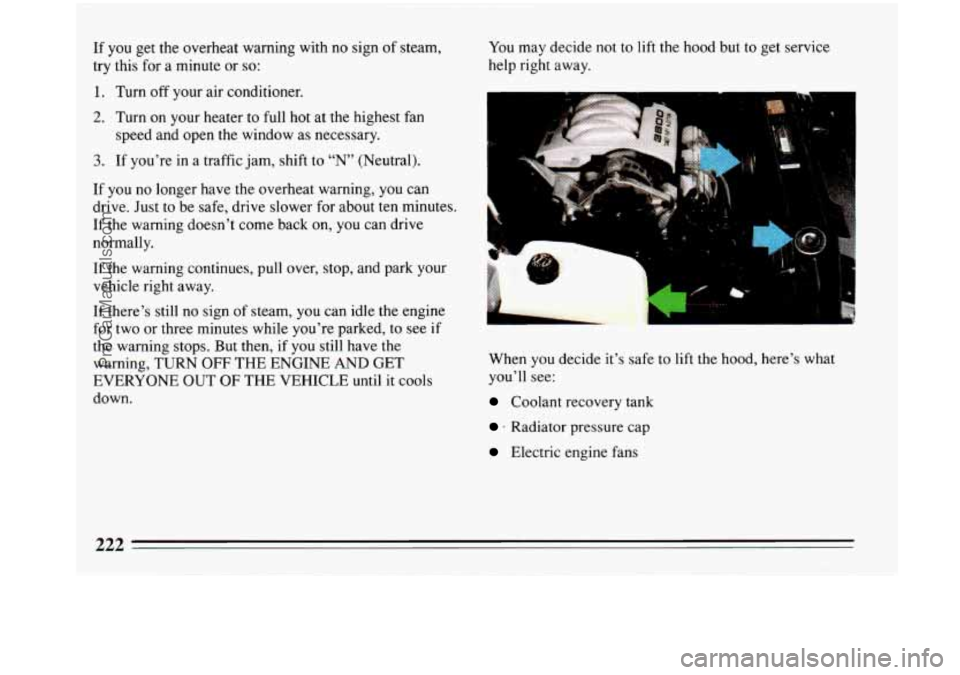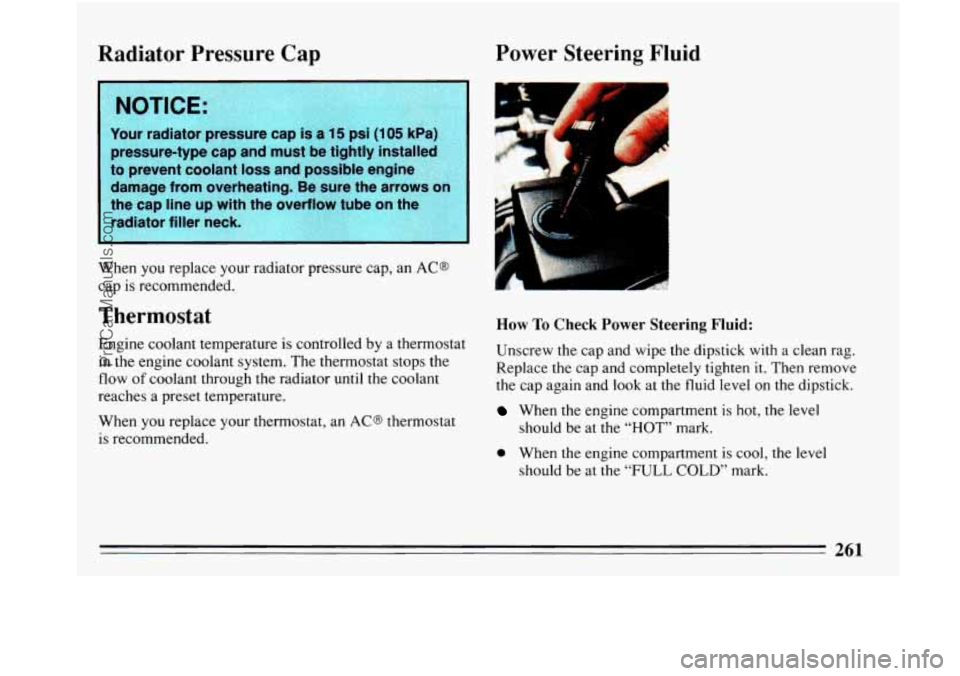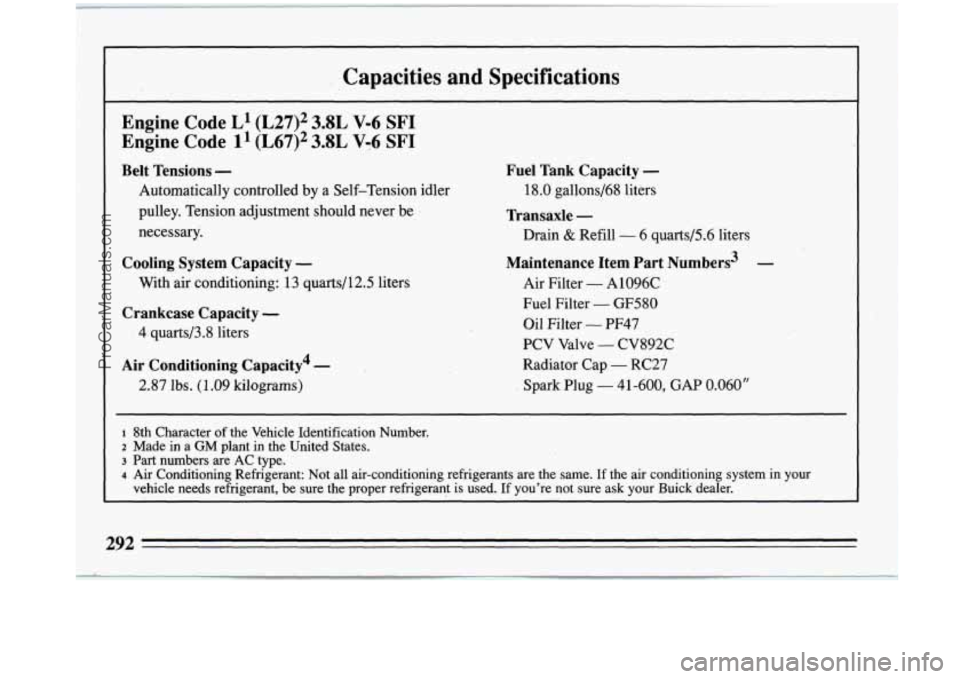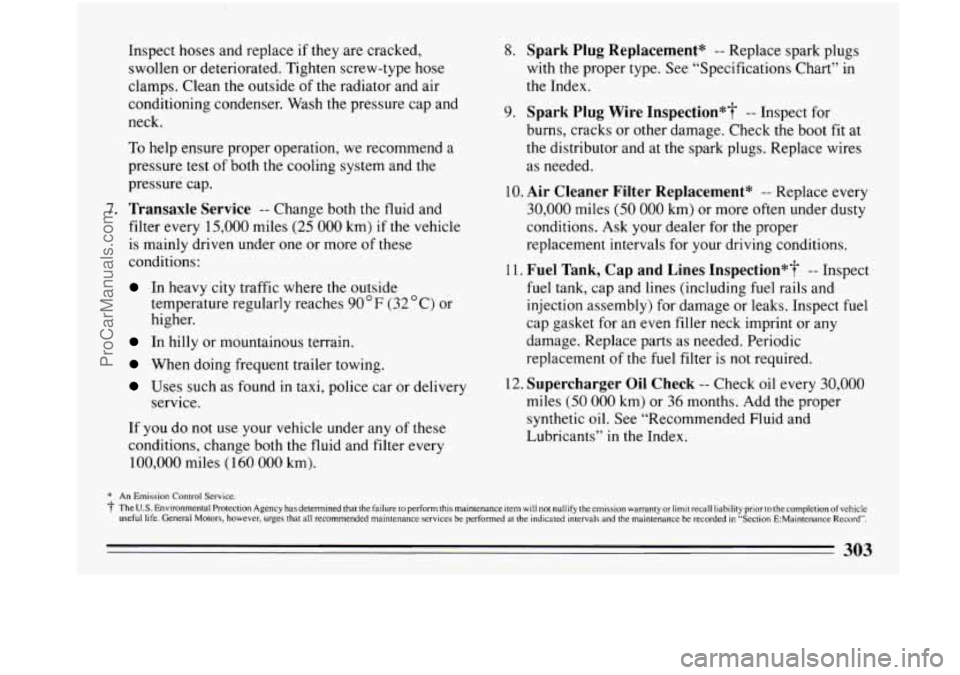Page 224 of 340

If you get the overheat warning with no sign of steam,
try this for a minute or
so:
1. Turn off your air conditioner.
2. Turn on your heater to full hot at the highest fan
speed and open the window as necessary.
3. If you’re in a traffic jam, shift to “N” (Neutral).
If
you no longer have the overheat warning, you can
drive. Just
to be safe, drive slower for about ten minutes.
If the warning doesn’t come back on,
you can drive
normally.
If the warning continues, pull over, stop, and park your
vehicle right away.
If there’s still no sign of steam, you can idle the engine
for two or three minutes while you’re parked, to see if
the warning stops. But then, if
you still have the
warning, TURN
OFF THE ENGINE AND GET
EVERYONE OUT
OF THE VEHICLE until it cools
down. You
may decide not to lift the hood but to get service
help right away.
e
w . ._
,
When you decide it’s safe to lift the hood, here’s what
you’ll see:
Coolant recovery tank
* Radiator pressure cap
Electric engine fans
ProCarManuals.com
Page 227 of 340
A CAUTION: A CAUTION:
You can be burned if you spill cootant on hot
engine parts. Coolant contains ethylene glycol
and it will burn if the engine parts are hot
enough. Don’t spill coolant on a hot engine.
When the coolant in the coolant recovery tank is at or
above
“FULL COLD,” start your vehicle.
If the overheat warning continues, there’s one more
thing you can try.
You can add the proper coolant mix
directly
to the radiator, but be sure the cooling system is
cool before
you do it.
Steam and scalding liquids from a hot cooling
system can blow out and burn you badly. They
are under pressure, and if you turn the radiator
pressure cap
-- even a little -- they can come out
at high speed. Never turn the pressure cap when
e cooling system, including the radiator
pressure cap, is hot. Wait for the cooling system
and radiator pressure cap to cool
if you ever
have
to turn the pressure cap.
L
L
ProCarManuals.com
Page 228 of 340
How to Add Coolant to the Radiator
1 1. You can remove the
radiator pressure cap when the
cooling system,
including the
radiator pressure
cap and upper
radiator hose,
is no
longer hot.
Turn the pressure cap slowly to the
left until it first
stops. (Don't press
down while turning the pressure
cap.)
2. Then keep turning the pressure cap,
but now push down
as
you turn it.
Remove the
pressure cap.
1
If you hear a hiss, wait for that to stop. A hiss means I
there is still some pressure left. i
3. Fill the radiator
with the proper
mix, up to the base
of the filler neck.
ProCarManuals.com
Page 229 of 340
4. Then fill the coolant recovery tank to “FULL
COLD.”
6. Start the engine and
let it run until you
can feel the upper
radiator hose
getting hot. Watch
out for the engine
fans.
7. By this time the coolant level inside the radiator
filler neck may be lower. If the level
is lower, add
more of the proper
mix through the filler neck until
the level reaches the top
of the filler neck.
5. Put the cap back on the coolant recovery tank, but
leave
the radiator pressure cap off.
227
ProCarManuals.com
Page 262 of 340
To Check Coolant: When your engine is cold, the
coolant level should be at
“FULL COLD,” or a little
higher. When your engine is warm, the level should be
up to
“FULL HOT,” or a little higher.
If this light comes
on, it means you’re low on engine
coolant.
To Add Coolant: If you need more coolant, add the
proper mix at the coolant recovery .tank.
‘ CAUTION:
T‘urning the radiator pressure cap when the
engine and radiator are hot can allow steam and
scalding liquids to blow out and burn you badly.
With the coolant recovery tank, you will almost
never have to add coolant at the radiator. Never
turn the radiator pressure cap -- even a little -
#hen the engine and radiator are hot.
I
Add coolant mix at the recovery tank, but be careful not
to spill it.
A CAUTION:
You can be burned if you spill coolant on hot
engine parts. Coolant contains ethylene glycol,
and it will burn
if the engine parts are hot
enough. Don’t spill coolant on a hot engine.
ProCarManuals.com
Page 263 of 340

Radiator Pressure Cap
Your radiator pressure cap is a 15 psi (105 kPa)
pressure-type cap and must be tightly install
to prevent coolant
loss and possible engine
damage from overheating. Be sure the arro
the cap line up with the
ov be on t
radiator filler neck.
Power Steering Fluid
When you replace your radiator pressure cap, an AC@
cap
is recommended.
Thermostat
Engine coolant temperature is controlled by a thermostat
in the engine coolant system. The thermostat stops the
flow
of coolant through the radiator until the coolant
reaches a preset temperature.
When
you replace your thermostat, an AC@ thermostat
is recommended.
How To Check Power Steering Fluid:
Unscrew the cap and wipe the dipstick with a clean rag.
Replace
the cap and completely tighten it. Then remove
the cap again and look at the fluid level on the dipstick.
When the engine compartment is hot, the level
should be at the
“HOT” mark.
0 When the engine compartment is cool, the level
should be at the “FULL COLD” mark.
ProCarManuals.com
Page 294 of 340

Capacities and Specifications
Engine Code L1 (L27)2 3.8L V-6 SF1
Engine Code
l1 (L67)2 3.8L V-6 SF1
Belt Tensions -
Automatically controlled by a Self-Tension idler
pulley. Tension adjustment should never be
necessary.
Cooling System Capacity -
With air conditioning: 13 quarts/l2.5 liters
Crankcase Capacity -
4 quarts/3.8 liters
Air Conditioning Capacity4 -
2.87 lbs. (1.09 kilograms)
Fuel Tank Capacity -
18.0 gallons/68 liters
Transaxle -
Drain & Refill - 6 quarts/5.6 liters
Maintenance Item Part Numbers3 -
Air Filter - A1096C
Fuel Filter
- GF580
Oil Filter
- PF47
PCV Valve
- CV892C
Radiator Cap
- RC27
Spark Plug
- 41-600, GAP 0.060”
~~~~ ~~~ -. ____ ____ ~~ -. ~~ ~ ~~ ~ ~
1 8th Character of the Vehicle Identification Number.
2 Made in a GM plant in the United States,
3 Part numbers are AC type.
4 Air Conditioning Refrigerant: Not all air-conditioning refrigerants are the same. If the air conditioning system in your
vehicle needs refrigerant, be sure the proper refrigerant is used.
If you’re not sure ask your Buick dealer.
292
ProCarManuals.com
Page 305 of 340

Inspect hoses and replace if they are cracked,
swollen or deteriorated. Tighten screw-type hose
clamps. Clean the outside of the radiator and air
conditioning condenser. Wash the pressure cap and
neck.
To help ensure proper operation, we recommend a
pressure test of both the cooling system and the
pressure cap.
7. Transaxle Service -- Change both the fluid and
filter every 15,000 miles (25
000 km) if the vehicle
is mainly driven under
one or more of these
conditions:
In heavy city traffic where the outside
temperature regularly reaches
90 OF (32 “C) or
higher.
In hilly or mountainous terrain.
When doing frequent trailer towing.
Uses such as found in taxi, police car or delivery
If you do
not use your vehicle under any of these
conditions, change both the fluid and filter every
100,000 miles
( 160 000 km).
service.
8. Spark
Plug Replacement* -- Replace spark plugs
with the proper type. See “Specifications Chart” in
the Index.
9. Spark Plug Wire Inspection*? -- Inspect for
burns, cracks or other damage. Check the boot fit at
the distributor and at the spark plugs. Replace wires
as needed.
10.
Air Cleaner Filter Replacement* -- Replace every
30,000 miles (50 000 km) or more often under dusty
conditions. Ask your dealer for the proper
replacement intervals for your driving conditions.
11.
Fuel Tank, Cap and Lines Inspection*? -- Inspect
fuel tank, cap and lines (including
fuel rails and
injection assembly) for damage or leaks. Inspect fuel
cap gasket for an even filler neck imprint or any
damage. Replace parts as needed. Periodic
replacement of the fuel filter
is not required.
12.
Supercharger Oil Check -- Check oil every 30,000
miles (50 000 km) or 36 months. Add the proper
synthetic
oil. S.ee “Recommended Fluid and
Lubricants’’ in the Index.
* An Emission Control Service.
? The U.S. Environmental Protection Agency has determined that the failure to perform this maintenance item will not nullify the emission warranty or limit recall liability prior to the completion of vehicle
useful life. General Motors, however, urges that all recommended maintenance services be performed at the indicated intervals and the maintenance be recorded in ‘‘Section E:Maintenance Record’‘.
303
ProCarManuals.com